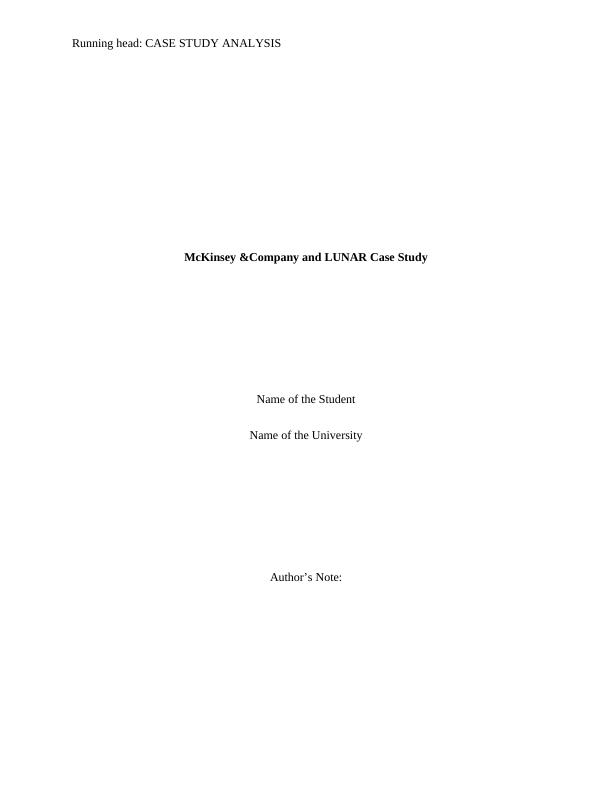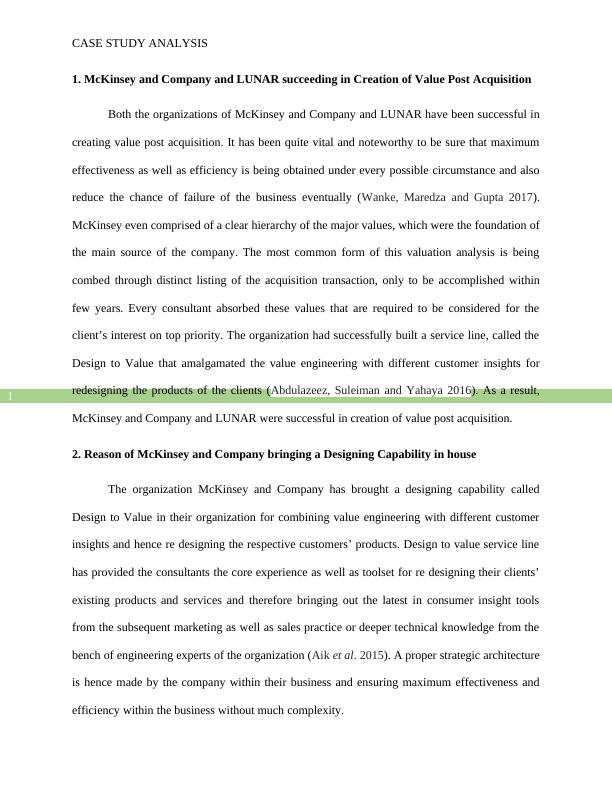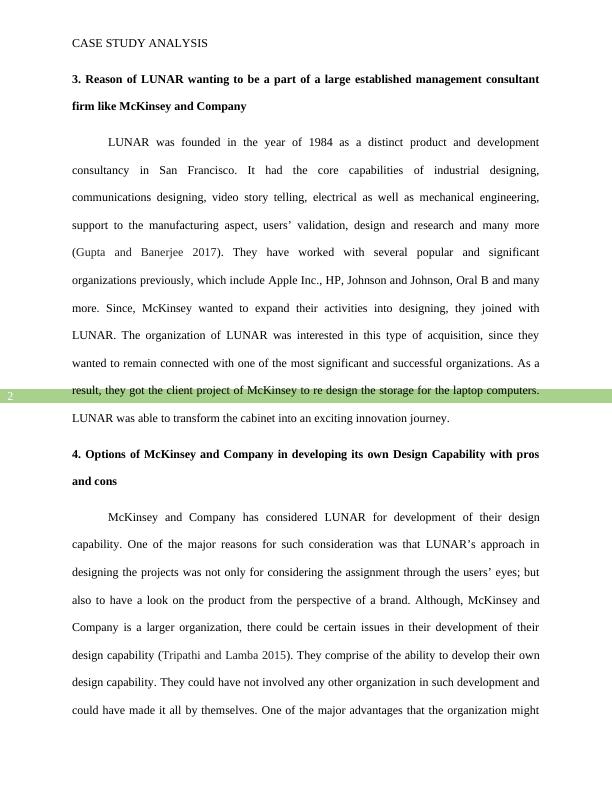McKinsey &Company and LUNAR Case Study 2022
Added on 2022-09-22
7 Pages1482 Words19 Views
Running head: CASE STUDY ANALYSIS
McKinsey &Company and LUNAR Case Study
Name of the Student
Name of the University
Author’s Note:
McKinsey &Company and LUNAR Case Study
Name of the Student
Name of the University
Author’s Note:

1
CASE STUDY ANALYSIS
1. McKinsey and Company and LUNAR succeeding in Creation of Value Post Acquisition
Both the organizations of McKinsey and Company and LUNAR have been successful in
creating value post acquisition. It has been quite vital and noteworthy to be sure that maximum
effectiveness as well as efficiency is being obtained under every possible circumstance and also
reduce the chance of failure of the business eventually (Wanke, Maredza and Gupta 2017).
McKinsey even comprised of a clear hierarchy of the major values, which were the foundation of
the main source of the company. The most common form of this valuation analysis is being
combed through distinct listing of the acquisition transaction, only to be accomplished within
few years. Every consultant absorbed these values that are required to be considered for the
client’s interest on top priority. The organization had successfully built a service line, called the
Design to Value that amalgamated the value engineering with different customer insights for
redesigning the products of the clients (Abdulazeez, Suleiman and Yahaya 2016). As a result,
McKinsey and Company and LUNAR were successful in creation of value post acquisition.
2. Reason of McKinsey and Company bringing a Designing Capability in house
The organization McKinsey and Company has brought a designing capability called
Design to Value in their organization for combining value engineering with different customer
insights and hence re designing the respective customers’ products. Design to value service line
has provided the consultants the core experience as well as toolset for re designing their clients’
existing products and services and therefore bringing out the latest in consumer insight tools
from the subsequent marketing as well as sales practice or deeper technical knowledge from the
bench of engineering experts of the organization (Aik et al. 2015). A proper strategic architecture
is hence made by the company within their business and ensuring maximum effectiveness and
efficiency within the business without much complexity.
CASE STUDY ANALYSIS
1. McKinsey and Company and LUNAR succeeding in Creation of Value Post Acquisition
Both the organizations of McKinsey and Company and LUNAR have been successful in
creating value post acquisition. It has been quite vital and noteworthy to be sure that maximum
effectiveness as well as efficiency is being obtained under every possible circumstance and also
reduce the chance of failure of the business eventually (Wanke, Maredza and Gupta 2017).
McKinsey even comprised of a clear hierarchy of the major values, which were the foundation of
the main source of the company. The most common form of this valuation analysis is being
combed through distinct listing of the acquisition transaction, only to be accomplished within
few years. Every consultant absorbed these values that are required to be considered for the
client’s interest on top priority. The organization had successfully built a service line, called the
Design to Value that amalgamated the value engineering with different customer insights for
redesigning the products of the clients (Abdulazeez, Suleiman and Yahaya 2016). As a result,
McKinsey and Company and LUNAR were successful in creation of value post acquisition.
2. Reason of McKinsey and Company bringing a Designing Capability in house
The organization McKinsey and Company has brought a designing capability called
Design to Value in their organization for combining value engineering with different customer
insights and hence re designing the respective customers’ products. Design to value service line
has provided the consultants the core experience as well as toolset for re designing their clients’
existing products and services and therefore bringing out the latest in consumer insight tools
from the subsequent marketing as well as sales practice or deeper technical knowledge from the
bench of engineering experts of the organization (Aik et al. 2015). A proper strategic architecture
is hence made by the company within their business and ensuring maximum effectiveness and
efficiency within the business without much complexity.

2
CASE STUDY ANALYSIS
3. Reason of LUNAR wanting to be a part of a large established management consultant
firm like McKinsey and Company
LUNAR was founded in the year of 1984 as a distinct product and development
consultancy in San Francisco. It had the core capabilities of industrial designing,
communications designing, video story telling, electrical as well as mechanical engineering,
support to the manufacturing aspect, users’ validation, design and research and many more
(Gupta and Banerjee 2017). They have worked with several popular and significant
organizations previously, which include Apple Inc., HP, Johnson and Johnson, Oral B and many
more. Since, McKinsey wanted to expand their activities into designing, they joined with
LUNAR. The organization of LUNAR was interested in this type of acquisition, since they
wanted to remain connected with one of the most significant and successful organizations. As a
result, they got the client project of McKinsey to re design the storage for the laptop computers.
LUNAR was able to transform the cabinet into an exciting innovation journey.
4. Options of McKinsey and Company in developing its own Design Capability with pros
and cons
McKinsey and Company has considered LUNAR for development of their design
capability. One of the major reasons for such consideration was that LUNAR’s approach in
designing the projects was not only for considering the assignment through the users’ eyes; but
also to have a look on the product from the perspective of a brand. Although, McKinsey and
Company is a larger organization, there could be certain issues in their development of their
design capability (Tripathi and Lamba 2015). They comprise of the ability to develop their own
design capability. They could have not involved any other organization in such development and
could have made it all by themselves. One of the major advantages that the organization might
CASE STUDY ANALYSIS
3. Reason of LUNAR wanting to be a part of a large established management consultant
firm like McKinsey and Company
LUNAR was founded in the year of 1984 as a distinct product and development
consultancy in San Francisco. It had the core capabilities of industrial designing,
communications designing, video story telling, electrical as well as mechanical engineering,
support to the manufacturing aspect, users’ validation, design and research and many more
(Gupta and Banerjee 2017). They have worked with several popular and significant
organizations previously, which include Apple Inc., HP, Johnson and Johnson, Oral B and many
more. Since, McKinsey wanted to expand their activities into designing, they joined with
LUNAR. The organization of LUNAR was interested in this type of acquisition, since they
wanted to remain connected with one of the most significant and successful organizations. As a
result, they got the client project of McKinsey to re design the storage for the laptop computers.
LUNAR was able to transform the cabinet into an exciting innovation journey.
4. Options of McKinsey and Company in developing its own Design Capability with pros
and cons
McKinsey and Company has considered LUNAR for development of their design
capability. One of the major reasons for such consideration was that LUNAR’s approach in
designing the projects was not only for considering the assignment through the users’ eyes; but
also to have a look on the product from the perspective of a brand. Although, McKinsey and
Company is a larger organization, there could be certain issues in their development of their
design capability (Tripathi and Lamba 2015). They comprise of the ability to develop their own
design capability. They could have not involved any other organization in such development and
could have made it all by themselves. One of the major advantages that the organization might

End of preview
Want to access all the pages? Upload your documents or become a member.
Related Documents
Design Thinking and Corporate Structure of Agendizelg...
|21
|4894
|490
Brief View of Marketinglg...
|18
|5303
|241
Innovation Process of IBM: A Study on Business Project Managementlg...
|15
|980
|357
Digital Disruption in Retail Sectorlg...
|14
|943
|59
Value and Contribution to Organizational Successlg...
|13
|3513
|78
IT Infrastructure Managementlg...
|9
|1422
|64
